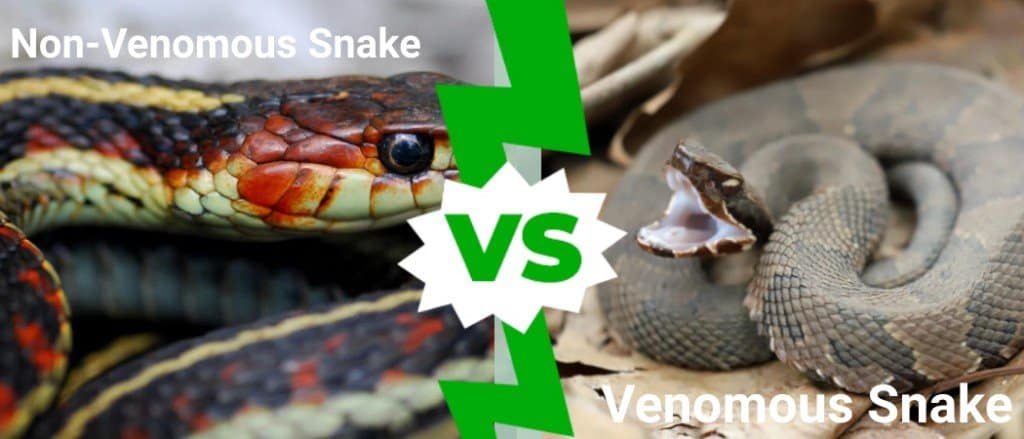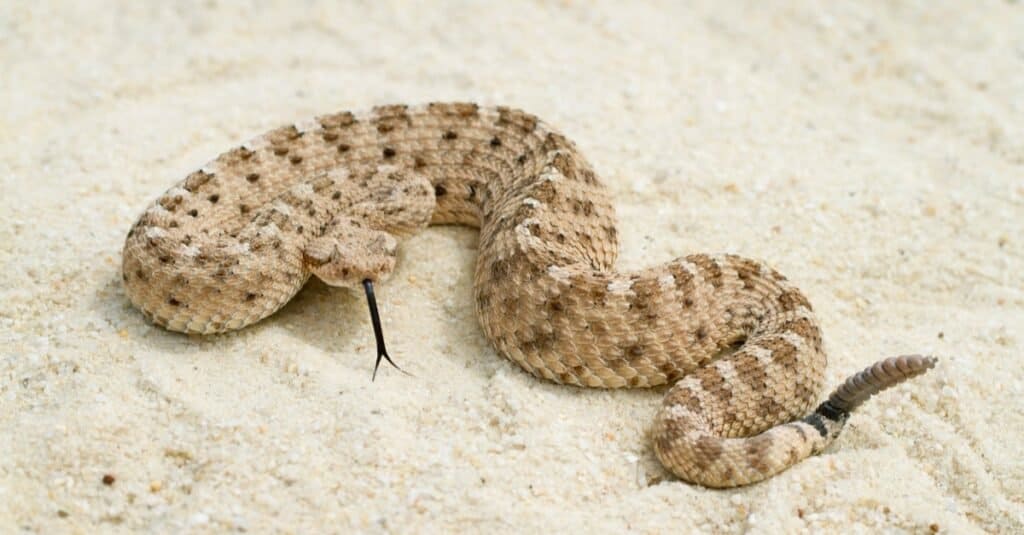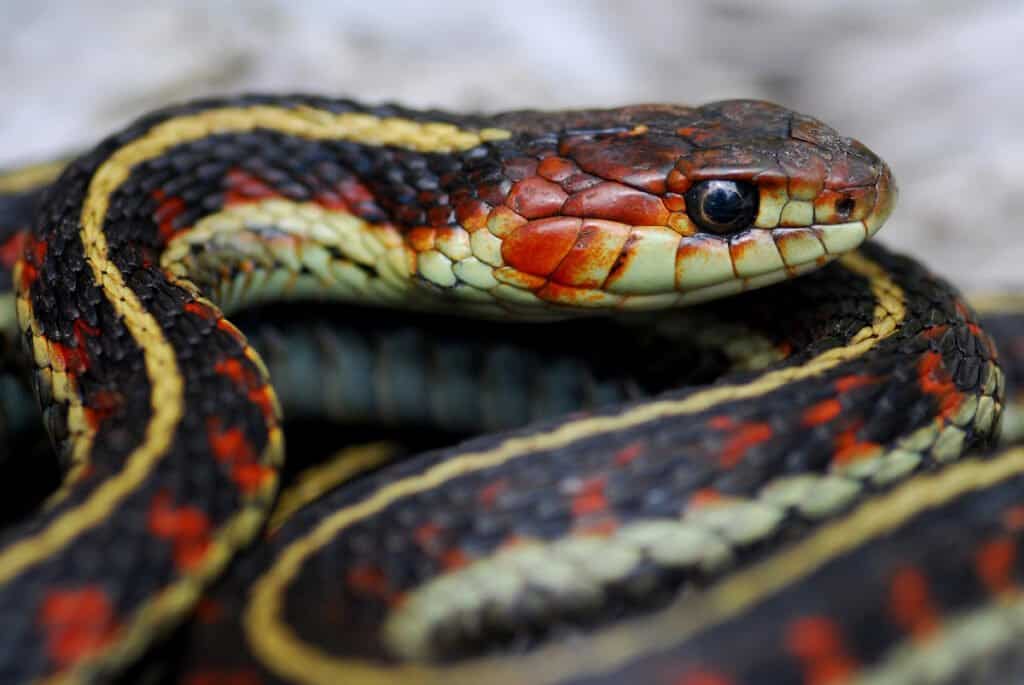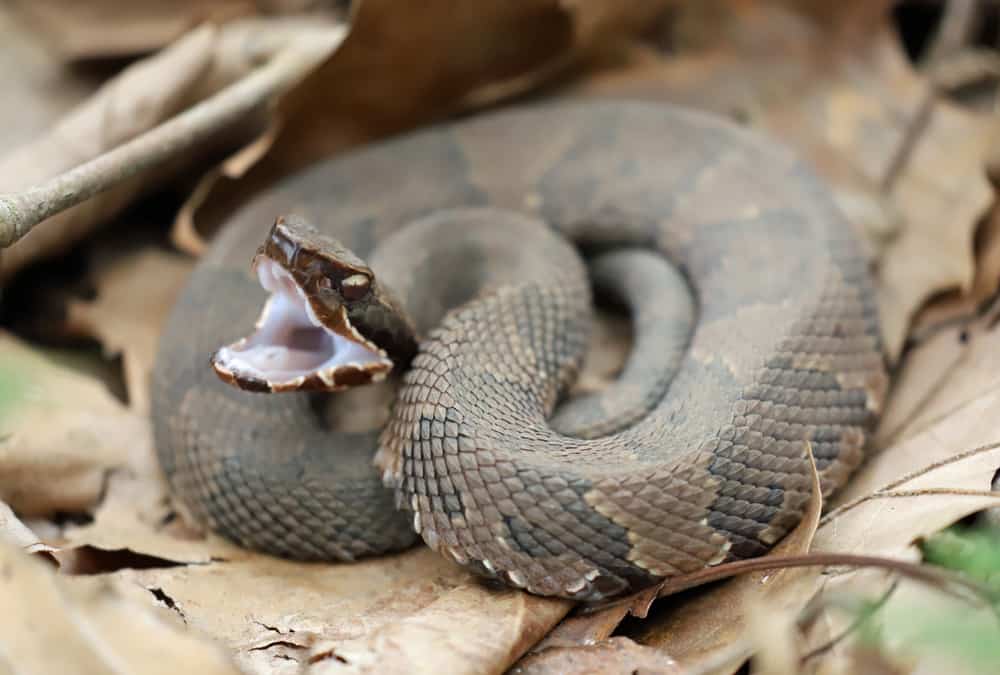Learning the differences between venomous and non-venomous snakes saves lives. Of course, it can be difficult to tell at first glance, especially if you aren’t familiar with snakes in North America. However, the difference between these two snake types becomes clear after a bit of study.
Knowing what to look for will give you confidence and peace of mind whenever you encounter a snake. You don’t have to get bitten by a venomous snake in order to identify it as such! Let’s go into detail about the key differences between venomous vs. non-venomous snakes in North America

Comparing Venomous vs. Nonvenomous Snakes
When you’re first learning how to tell venomous and nonvenomous snakes apart, you’ll hear things like:
- Venomous snakes have cat’s-eye (vertical) pupils (not always).
- All venomous snakes have triangular heads (not always).
- Most venomous snakes have a rattle (only in the Americas).
We’re going to show you where these ideas work and where they don’t. Suffice it to say that you should never rely on one physical trait to determine whether a snake is venomous or not. Taken in conjunction, you can usually figure it out safely. However, if you are not 150% positive, get an expert for help moving a snake.
The 5 Key Differences Between Venomous vs. Nonvenomous Snakes in North America
There are key differences that separate venomous vs. nonvenomous snakes. Obviously, venomous snakes have fangs and venom glands; in some species, that makes their heads look really chunky. In others, it doesn’t.
Pit vipers are the only venomous snakes you can encounter throughout much of North America. However, from the southern one-third of the U.S. and south, several highly venomous coral snakes also occur. These snakes have different physical traits, and the rules for identifying pit vipers do not apply.
That said, if you encounter a snake with a rattle, it is a venomous rattlesnake. That is the only type of snake with a rattle! No nonvenomous snakes have rattles. Many venomous snakes also have a different head and pupil shape when compared to non-venomous snakes.
Let’s dive a little deeper into what makes venomous and nonvenomous snakes so different.

Compared to non-venomous ones, venomous snakes often have different head and pupil shapes.
©iStock.com/BobMcLeanLLC
Venomous vs. Nonvenomous Snakes: Venom
One of the key differences between venomous vs. non-venomous snakes is the presence of venom. It may sound obvious that venomous snakes have medically significant venom while non-venomous snakes don’t, but this is a key distinction to make between these two types of snakes.
Nonvenomous snakes can still bite, and some have mild prey-specific venom. Additionally, they’re often far more willing to bite than venomous snakes. However, no matter how cranky they behave, these harmless snakes can’t hurt you.

Venomous snakes often have a rattle on the end of their tails.
©Mark_Kostich/Shutterstock.com
Venomous vs. Nonvenomous Snakes: Head Shape
One difference between venomous pit vipers and nonvenomous snakes is their head shape. This can be a fantastic way of telling these two types of snakes apart, especially if you stumble upon one in the wild. Venomous snakes often have a triangular-shaped head with a noticeably thinner neck, while nonvenomous snakes have a more rounded head that’s only barely distinct from the neck.
However, all nonvenomous snakes can mimic venomous snakes as a defense mechanism, flattening their heads to appear bigger. This can lead to some confusion, especially when you’re trying to decide if it’s a water snake or a cottonmouth.
Of course, this rule does not apply to coral snakes and boas. Nonvenomous boas have more arrow-shaped heads, and venomous coral snakes have rounded heads.
Venomous vs. Nonvenomous Snakes: Pupil Shape and Presence of Loreal Pits
Another easy difference between venomous vs. non-venomous snakes is their pupils’ shape and loreal pits’ presence. Most of the time. Venomous pit vipers have vertical pupils similar to cats’ eyes.
Nonvenomous snakes often have round pupils, except for boas and venomous coral snakes. Boas are often nocturnal and have vertical pupils, while coral snakes are often diurnal and take advantage of round pupils.
Another key distinction between venomous vs. nonvenomous snakes in North America is the presence of pits on their face. If you see what looks like an extra nostril between the snake’s eye and the actual nostril, you’re looking at a pit viper.
Of course, those tricky cobra cousins don’t have heat-sensing loreal pits. Nope, venomous coral snakes do not have the same amazing ability to sense heat in three dimensions.

A difference between some venomous and nonvenomous snakes is their pupil shape.
©Jason Mintzer/Shutterstock.com
Venomous vs. Non-Venomous Snakes: Presence of a Rattle
We know that not all venomous snakes have rattles. However, if the snake has a rattle, it is venomous. There is no further identification needed unless you want a definite species identification.
However, not all venomous snakes have a rattle- it is meant to be an automatic tell rather than an absolute rule. Non-venomous snakes can also mimic the sound of a snake’s rattle by rattling their tail tip into leaves or against the ground.
This is an important distinction to make between the two types of snakes. If you hear a rattle, always look for one on the end of the snake’s tail- though hearing a rattle is a good sign to back off, no matter the type of snake!

Venomous snakes often have triangular-shaped heads with very thin necks.
©KF2017/Shutterstock.com
Venomous vs Nonvenomous Snakes: Markings and Color
The final key difference between venomous and non-venomous snakes is their markings and colorings. There are always exceptions to the rule here, including aberrant patterns and patternless or even albino animals. However, learning the particular markings of the venomous snakes in your part of North America can help you narrow down the list of suspects.
Most of the time, if a North American snake is solid-colored, it’s nonvenomous. However, snakes like cottonmouths often get so dark as they age that the pattern is almost invisible. So, relying solely on patterns can earn you a hospital trip.
Venomous vs. Nonvenomous Snakes: Location
One last thing. Herpetologists often use location as a way to narrow down the list of possibilities. For example, you’re not going to find a coral snake in Michigan unless it escaped or someone released it. You’re also not going to find a rattlesnake (or nearly any snake) in Alaska.
Using tools like iNaturalist.org help you eliminate snakes that aren’t possible and select a few that might be possible.
The photo featured at the top of this post is ©
Discover the "Monster" Snake 5X Bigger than an Anaconda
Every day A-Z Animals sends out some of the most incredible facts in the world from our free newsletter. Want to discover the 10 most beautiful snakes in the world, a "snake island" where you're never more than 3 feet from danger, or a "monster" snake 5X larger than an anaconda? Then sign up right now and you'll start receiving our daily newsletter absolutely free.
Thank you for reading! Have some feedback for us? Contact the AZ Animals editorial team.






